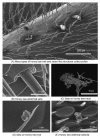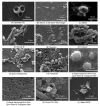Potential Risk to Pollinators from Nanotechnology-Based Pesticides
- PMID: 31817417
- PMCID: PMC6943562
- DOI: 10.3390/molecules24244458
Potential Risk to Pollinators from Nanotechnology-Based Pesticides
Abstract
The decline in populations of insect pollinators is a global concern. While multiple factors are implicated, there is uncertainty surrounding the contribution of certain groups of pesticides to losses in wild and managed bees. Nanotechnology-based pesticides (NBPs) are formulations based on multiple particle sizes and types. By packaging active ingredients in engineered particles, NBPs offer many benefits and novel functions, but may also exhibit different properties in the environment when compared with older pesticide formulations. These new properties raise questions about the environmental disposition and fate of NBPs and their exposure to pollinators. Pollinators such as honey bees have evolved structural adaptations to collect pollen, but also inadvertently gather other types of environmental particles which may accumulate in hive materials. Knowledge of the interaction between pollinators, NBPs, and other types of particles is needed to better understand their exposure to pesticides, and essential for characterizing risk from diverse environmental contaminants. The present review discusses the properties, benefits and types of nanotechnology-based pesticides, the propensity of bees to collect such particles and potential impacts on bee pollinators.
Keywords: Bees; Environmental pollution; Exposure potential; Nanotechnology-based particles; Particulate matter; Pesticides; Pollinators.
Conflict of interest statement
The authors declare no conflicts of interest.
Figures







References
Publication types
MeSH terms
Substances
Grants and funding
LinkOut - more resources
Full Text Sources
Medical

